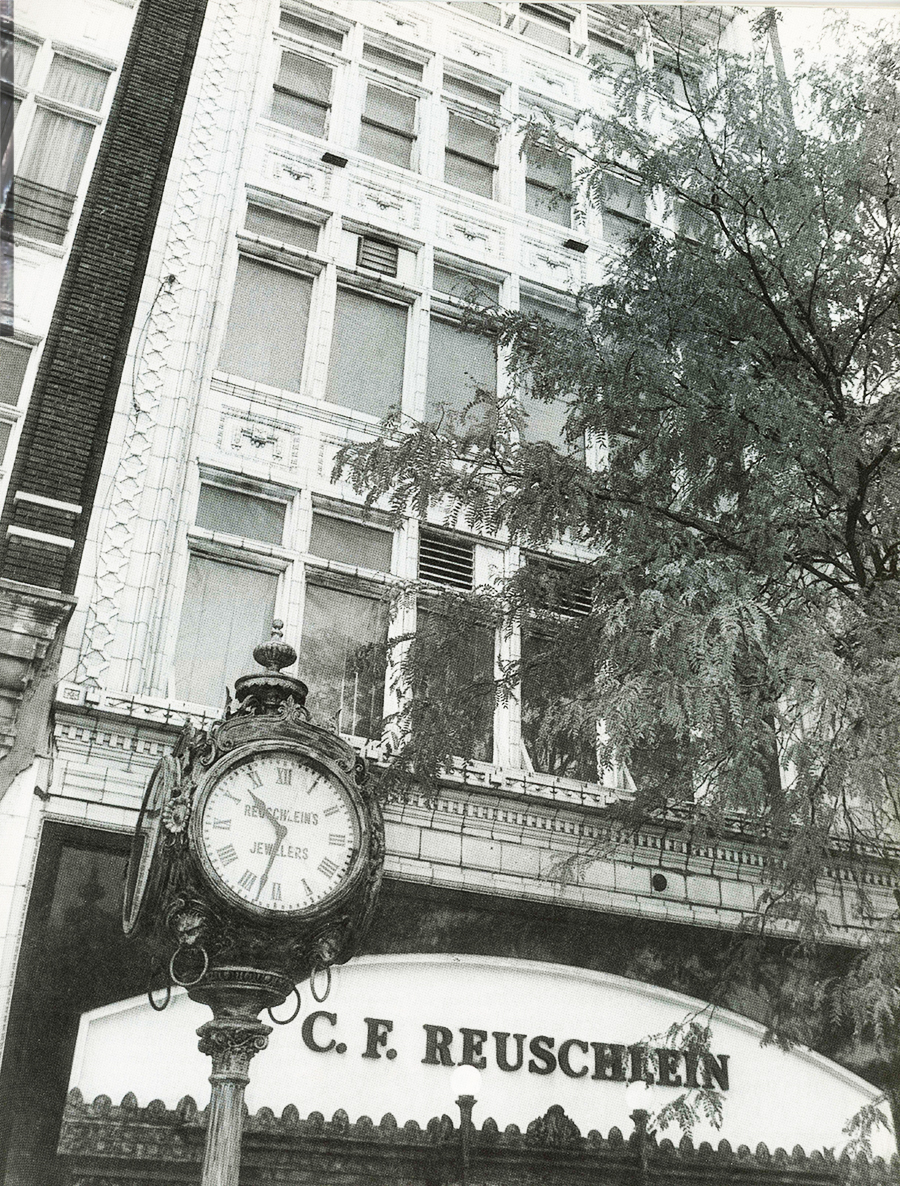For more than 100 years, C.F. Reuschlein Jewelers has been renowned for its rare quality and quiet sophistication
By Joseph Platania
HQ 16 | AUTUMN 1993
As soon as you open the door at the bronze and marble entrance of C. F. Reuschlein, Inc., Jewelers and cross the lobby with its ceramic tile floor, you realize that you are not in an ordinary jewelry store. Inside the long carpeted showroom, Waterford crystal chandeliers hang from vaulted ceilings. Displays of Royal Doulton and Wedgewood table settings line one side of the room while silver shines in wood-and-glass cabinets on the other. The elegant surroundings are accented by a library-like stillness.
Stores, like people, have personalities. Their image or character is reflected by many facets that make for a viable retail operation. Some sparkle like diamonds, others are dull and uninspiring. This vital ingredient of identification is really the most important difference between one store and another. Everything related to appearance, product and operation has an effect on a store’s image.
For most of its history, C. F. Reuschlein has been nationally known for the quality of its jewelry and for its atmosphere of quiet elegance. Nearly 20 years ago, this old established firm put on a handsome new face without sacrificing its character lines or image. It now is known for its exterior and interior appearance.
Like many successful, long-lasting businesses, Reuschlein’s had a modest beginning. In the fall of 1891, a jeweler named Harry J. Homrich, a native of Martinsburg, W. Va. came to Huntington from Columbus, Ohio, where he had been a watch salesman. Prior to that, he owned and operated a jewelry store in Martinsburg. In April 1892, Homrich opened his new jewelry store at 915 3rd Avenue.
Homrich had good reason to locate his business in Huntington, then a bustling young city of more th:vi 10,000 residents. Huntington was served by the trains of the C&O Railway and, a few years later, by the B&O System. There were electric streetcars rolling on rails down wide 3rd Avenue linking downtown with Guyandotte. At the time, 3rd Avenue was the city’s busiest thoroughfare with businesses of every description lining the avenue.
An early advertisement for Homrich’s store stated that it featured “a better assortment of Clocks, Watches, Diamonds, Jewelry, Gold and Silverware, together with the rarest novelties.” He billed himself as “The Popular Third Avenue Jeweler.”

Homrich kept his store on 3rd Avenue until 1914 when he moved into a new building at 316 9th Street ( the building would later house Nasser’s women’s clothing business).
In 1903, Charles F. Reuschlein, who had recently moved to Huntington from his hometown of Cumberland, Maryland, became associated with Homrich in the jewelry business. This association continued until Homrich retired on Dec. 31, 1931. Shortly thereafter, Reuschlein purchased most of Homrich’s merchandise at a public auction, and rented the 9th Street building.
George S. Wallace’s 194 7 history of Huntington described the jewelry store as “the oldest of its kind in Huntington.” Wallace also stated that “from the start he (Homrich) handled only the best in the jewelry line and catered to the better trade.”
When Reuschlein took over the business in 1932, “he maintained its high standards and enjoyed the patronage of discriminating buyers of the Tri-State,” Wallace wrote.
About three years after Reuschlein opened his store, he hired 15-year-old William A. “Buck” Thompson as. a sweeper and all-around errand boy. Thompson later became the store’s vicepresident and manager.
In an interview, Buck Thompson recalled that he learned the jewelry business under Reuschlein’s guidance. “He had great mechanical skills in engraving, jewelry, watch and clock repair. He could do it all,” said Thompson.
In 1937, Huntington was still feeling the effects of the Great Depression. In addition, downtown merchants also suffered the hardships of the 193 7 Ohio River flood that inundated much of the city. Thompson recalled that Mr. Reuschlein had the jewelry counters stacked atop wooden horses in an attempt to prevent flood damage, but to no avail. After the high water had receded, the long process of cleaning up began. “I can remember being at the back of the store with a hose, trying to spray all the mud and silt out the front door, ” Thompson said.
A supposedly airtight vault gushed water when it was opened, Thompson recalled, and a 19 14 vintage cash register, which continues to be used in the store, “rang up a drawerful of mud. “
After service in the Navy dur ing World War II and a few years with the FBI, Thompson returned to Reuschlein ‘s in 1947. The following year, the store moved to 940 3rd Avenue, across from its original location.
Looking back on those early years, Thompson said that “in the ’30s and ’40s , silver was big and it brought in a lot of customers. ” He recalled former Reuschlein employee Lady Lou Jenkins, who began working there in the early ’30s.
“She was well -known in Huntington and active in the Community Players and other organizations, and she brought in a lot of business, ” he said.
He added that one year Lady Lou gave out several hundred silver teaspoons to young women in Huntington as publicity for the store and to get their business when they planned their weddings.
“Back then the spoons were $1 each, ” said Thompson. ” Now they sell for $60. “
On Jan. 12, 1963, Charles F. Reuschlein died at the age of 85. Buck Thompson recalls that the store ‘s founder was an active re tailer well in to his 80’s, and left a legacy of exemplary business dealings.

“Mr. Reuschlein was straight and honest with everyone, ” Thompson said. “He was the most honest man I ever knew. “
During the ’60s and ’70s, changes were taking place in retailing and that included the jewelry business.
“Your jeweler used to be like your lawyer or your doctor, ” Thompson said. “These days, people shop around for price.”
Because of their beauty and intrinsic value, diamonds have been a mainstay in the jewelry trade. Thompson recalled that some years ago, a wealthy coal operator offered to buy $500,000 worth of diamonds from Reuschlein ‘s as an investment. However, Thompson turned the man down because, in his opinion, “diamonds are for love and affection” and not to be purchased solely as an investment.
Another upheaval for downtown merchants came in the early 1970s when the local urban renewal project got underway. Blocks of buildings along the north side of3 rd Avenue we re slated for demolition, and that included Reuschlein ‘s building.
Store officials decided on a five -story building at 82 5 4th Avenue – formerly the Morgan Arcade – as the new site for the jewel ry store. The building was purchased and remodeled by the Streater Division of Litton Industries. The first floor became the showroom, and the basement was remodeled for merchandising and storage.
After the remodeling was completed, life -size photographs of Reuschlein ‘s were displayed at a jewelers convention in Atlanta as an example of how new and old components could be integrated into a retail store ‘s design.
Reuschlein ‘s new exterior included the overhanging copper frieze, which had been moved from the 3rd Avenue location. Inside, some of the fixtures date back to the 1 9 14 store on 9th Street, including a large cash register which is painted with gold leaf. Many of the early fixtures are in the front of the store.
Another tie to the past is Reuschlein ‘s tall, stately clock that has been telling the time in down town Huntington for more than 100 years. The clock has traveled with the store since its founding, and now stands on the side walk in front of the firm’s present site at 82 5 4th Avenue.
It is believed that H . J. Homrich purchased the timepiece shortly after he opened his store in 1892 to use as a symbol for his business. The clock is regarded by many in Hunting ton as a quasi -historical landmark.
A local clock expert has stated that the 20 -foot high, four -faced, cast iron clock was made in Europe by the Seth Thomas Clock Co. in the late 1880s. It is one of only six of its kind in the world. The clock weighs approximately three tons and has columns which support the three-foot-wide dial face.
The timekeeper has bronze lion heads on the base that illuminate the dial faces at night. The clock, which has been called “a piece of late 19th century Americana,” has survived not only the high water of the 193 7 flood, but also the impact of an out-of-control truck on a rainy night in May 1968.
Thompson explained that the truck apparently slid on rain-slick 3rd Avenue after midnight and sideswiped the clock, sending it crashing to the sidewalk. The next morning, Thompson was notified by police that the antique had been severely damaged. By that time, the culprit was gone. Police investigators discovered bits of the truck’s running lights embedded in the clock’s base which was how they determined what had happened.
Thompson recalls that some people advised him against trying to restore the timepiece since it was thought to be beyond repair. But Ray Gallaher, a former jeweler with Reuschlein’s, and a team of clock repairmen and artists spent ten months restoring the firm’s trademark to its near-original condition. The clock does not keep time as reliably as it once did, but it is still an integral part of the store’s exterior.
Thompson, who retired in May 1993, said that Reuschlein’s is the only store with an on-site jewelry repair shop staffed by a full-time jeweler, polisher and Rolex-trained watch repairman.
Following C. F. Reuschlein’s death, his daughter took over ownership. Later, her daughter became owner and president of the company.
The new owner and majority stock holder isJ oe Chapman, who has worked at Reuschlein’s since 1969 and is a certified gemologist. Chapman and the store’s other employees continue to serve the public in the oldest retail business in downtown Huntington.
With a new exterior and a spacious, well-lighted interior, C. F. Reuschlein, Inc. begins its second century as one of the brightest jewels in the city’s central business district.





